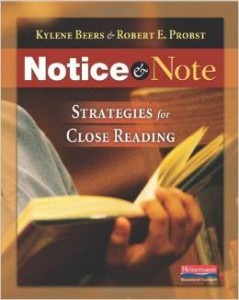This summer I read a fantastic book ” Notice and Note: Strategies for Close Reading”
““Just as rigor does not reside in the barbell but in the act of lifting it, rigor in reading is not an attribute of a text but rather of a reader’s behavior-engaged, observant, responsive, questioning, analytical. The close reading strategies in Notice and Note will help you cultivate those critical reading habits that will make your students more attentive, thoughtful, independent readers.”
-Kylene Beers and Robert E. Probst
This was a great “AHA” moment for me.
- What was I doing to change the reading behavior of my students?
- Did I give them strategies to enable them to dissect the text ?
- Was there discussions when we read together or was the act of reading more passive?
- Was I insuring that we went beyond the basics ?
I would strongly suggest reading this book and then applying the information in your classroom or therapy session. There are supporting documents including bookmarks that remind the student about what to look for.
The six signposts that Beer and Probst were especially enlightening:
- CONTRASTS & CONTRADICTIONS When a character does something that contrasts with what you’d expect or contradicts his earlier acts or statements, STOP and ask, “Why is the character doing that?” The answer will help you make predictions and draw inferences about the plot and conflict.
- WORDS OF THE WISER When a character (probably older and wiser) takes the main character aside andoffers serious advice, STOP and ask, “What’s the life lesson and how might if affect the character?” This lesson is probably the theme of the story.
- AHA MOMENT When a character realizes, understands, or finally figures out something, STOP and askyourself, “How might this change things?” If it is about a problem, it tells you something about the conflict; if it is a life lesson, it tells you something about the theme.
- AGAIN & AGAIN When you notice a word, phrase, or situation mentioned over and over, STOP and ask yourself,“Why does this keep happening again and again?” The answer will tell you about thetheme and conflict, or will foreshadow what might happen later in the story.
- MEMORY MOMENT When the author interrupts the action to tell you about a memory, STOP and ask yourself,“Why might this memory be important?” The answer will tell you about the theme and conflict,or will foreshadow what might happen later in the story.
- TOUGH QUESTIONS When a character asks himself a very difficult question, STOP and ask yourself, “What does this question make me wonder about?” The answer will tell you about the conflict, and help you think about what might happen later in the story.
I plan on using the bookmarks and setting up some picture books that we can practice “close reading” prior to doing it on more complex tasks.
What have you done to teach comprehension strategies?


